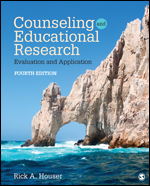Counseling and Educational Research: Evaluation and Application prepares readers to be good consumers and evaluators of research. Using concrete examples from published articles, author Rick A. Houser teaches students to take a systematic approach to evaluating professional literature critically and using it responsibly. The
Fourth Edition covers evidence-based research, qualitative methods, program evaluation, and mixed methods; includes new discussions on how national accreditation standards in counseling (CACREP) and education (CAEP) apply to research; and examines how cultural influences can affect the research process.
ISBN: 9781544305059
eBook
Suggested Retail Price: $52.00
Bookstore Price: $41.60
ISBN: 9781544305059
eBook
Suggested Retail Price: $58.00
Bookstore Price: $46.40
ISBN: 9781544305059
eBook
Suggested Retail Price: $65.00
Bookstore Price: $52.00
ISBN: 9781544305059
eBook
Suggested Retail Price: $94.24
Bookstore Price: $75.39
ISBN: 9781544305066
Paperback
Suggested Retail Price: $135.00
Bookstore Price: $108.00
See what’s new to this edition by selecting the Features tab on this page. Should you need additional information or have questions regarding the HEOA information provided for this title, including what is new to this edition, please email sageheoa@sagepub.com. Please include your name, contact information, and the name of the title for which you would like more information. For information on the HEOA, please go to http://ed.gov/policy/highered/leg/hea08/index.html.
For assistance with your order: Please email us at textsales@sagepub.com or connect with your SAGE representative.
SAGE
2455 Teller Road
Thousand Oaks, CA 91320
www.sagepub.com
Foreword
Preface
Acknowledgments
About the Author
Section 1: Introduction to the Research Process
Definitions of Science and Research
Practitioner–Scientist
Assumptions About Science and Research
Plagiarism
Steps in the Scientific Process
Purpose and Overview of the Text
Ethical Principles and Guidelines
Ethical Research Violations
Guidelines and Questions for Evaluating the Research Literature for Ethical Concerns
Evaluation of Research Examples Presented in the Professional Literature
Tuskegee Syphilis Study
Milgram Study
Strengths and Weaknesses of Quantitative Research
Types of Variables
Research Designs
Advantages and Disadvantages of Qualitative Research
Traditions or Paradigms in Conducting Qualitative Research
Case Study Approach
History of Mixed Methods Research
Strengths and Weaknesses of Mixed Methods Research
Triangulation
Mixed Research Models
Guidelines and Procedures in Single-Subject Design
Research Designs in Single-Case or Subject Research
Measurement Scales
Common Statistical Definitions
Descriptive Statistics
Inferential Statistics
Nonparametric Statistics
Generating Data: Units of Data Collection
Organizing Data
Management of Data: Coding and Reducing
Interpreting and Reporting
Section II: Evaluating Articles in the Professional Literature
Guidelines and Questions for Evaluating Research
Evaluation of Examples From the Research Literature
Guidelines and Questions for Evaluating the Purpose Statement
Evaluation of Examples From the Research Literature
Section Summary
Quantitative Research Hypotheses
Indirect Proof: An Orientation to the Scientific Approach
Types of Hypotheses
Guidelines and Questions for Evaluating Hypotheses: Quantitative Methods
Evaluation of Examples From the Research Literature
Evaluating a Hypothesis in Qualitative Research Methods
Guidelines and Questions for Evaluating Hypothesis or Hypotheses for Qualitative Research
Sampling Methods Used in Quantitative Research
Guidelines and Questions for Evaluating the Methods Section Sample
Evaluating Examples From the Research Literature
Standardization of Instruments
Culture, Gender, and Diversity Bias
Reliability of Instruments
Validity of Instruments
Approaches to Measuring the Dependent Variable
Guidelines and Questions for Evaluating the Instruments—Quantitative Research
Evaluating Examples From the Research Literature—Quantitative Research
Guidelines and Questions for Evaluating the Instruments—Qualitative Research
Evaluating Single-Subject Research
Description of Study Variables
Random Assignment
Internal and External Validity
Threats to Internal Validity
Threats to Validity with Single-Subject Studies
Threats to External Validity
Evaluation of Procedures Examples From the Literature
Part I: Quantitative Research Results
Descriptive Statistics
Inferential Statistics
Guidelines and Questions for Evaluating the Results Section—Quantitative Research
Evaluating Examples From the Research Literature—Quantitative Research
Single Case Study Example
Part II: Qualitative Research Results
Coding Data: Data Analysis
Guidelines and Questions for Evaluating the Results Section—Qualitative Research
Evaluating an Example From the Results Section—Qualitative Research
Guidelines and Questions for Evaluating the Discussion Section
Evaluating Examples From the Research Literature
Single-Subject Case Example
Section III: The Application of Research and Evaluation
Counseling Meta-Analyses
Interventions in Schools
Integrative Reviews
Cultural Neuroscience Research
Examples of Cultural and Neuroscience Research
Practitioner–Researchers
Developing a Research Proposal
Practical Considerations in Conducting Research
Definitions of Program Evaluation Research
Professional Standards and Guidelines for Program Evaluation
Types of Evaluation
Evaluation Models
Steps in an Evaluation
Examples of Program Evaluation
Technologies
Online Counseling
Interactive Video
Bug-in-Ear Technology
iPads and iPhones
Virtual Reality
Neuroscience Technologies
The Practitioner–Scientist Model
The Relevance of Research to Practice
Value Issues in Counseling
Social Justice Issues
Glossary
References
Index
Instructor Resource Site
study.sagepub.com/houser4e
A test bank for instructors is available with this text on the password-protected Instructor Resource Site. The test bank provides a diverse range of questions with the opportunity to edit any question and/or insert personalized questions to effectively assess students’ progress and understanding.
NEW TO THIS EDITION:
- Chapter-ending discussions show how national accreditation standards in counseling (CACREP) and education (CAEP) apply to chapter topics.
- Discussion of how cultural influences can affect the research process reflect an important sensitivity to cultural factors when studying today's diverse society.
- New chapters cover cultural issues to consider when conducting research and evidence-based research and application.
- Additional examples help illustrate how to evaluate research and professional journal articles.
KEY FEATURES:
- Reader-friendly language helps facilitate understanding without compromising the complexity of content.
- Exercises and activities provide opportunities for readers to engage with and think critically about chapter content.
- Summaries allow readers to review chapter content and reinforce their learning.

